Bank of Montreal
The Bank of Montreal (French: Banque de Montréal) is a Canadian multinational investment bank and financial services company. Founded in Montreal, Quebec in 1817 as Montreal Bank[1], its head office remains in Montreal, with its operational headquarters and executive offices located in Toronto, Ontario since 1977. One of the Big Five banks in Canada, it is the fourth-largest bank in Canada by market capitalization and assets, as well as one of the ten largest banks in North America. It is commonly known by its acronym BMO (pronounced /ˈbiːmoʊ/), which is also its stock symbol on both the Toronto Stock Exchange and the New York Stock Exchange.[7]
 | |
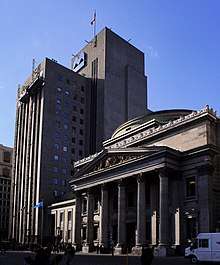 Bank of Montreal Head Office | |
| BMO Financial Group (US) BMO Bank of Montreal (Canada) | |
Formerly | Montreal Bank (1817-1822)[1] |
Type | Public |
| Traded as | TSX: BMO NYSE: BMO |
| ISIN | CA0636711016 |
| Industry | Financial services |
| Founded | As Montreal Bank: 23 June 1817 in Montreal, Lower Canada As Bank of Montreal: 1822 in Montreal, Lower Canada |
| Headquarters | Montreal, Quebec, Canada Toronto, Ontario, Canada[note 1] |
Key people | Patrick Cronin (CRO, BMO Financial Group) Robert Prichard (Chair of the Board, BMO Financial Group) Thomas E. Flynn (CFO, BMO Financial Group) Dave Casper (CEO, BMO Harris Bank) Darryl White (CEO BMO Financial Group) |
| Revenue | |
| Total assets | |
Number of employees | 45,513 (FTE, F2019)[5] |
| Subsidiaries | BMO Capital Markets BMO Harris Bank BMO Nesbitt Burns |
| Website | Canada: bmo US: bmoharris Capital Markets: bmocm |
On 23 June 1817, John Richardson and eight merchants signed the Articles of Association to establish the Montreal Bank in a rented house in Montreal, Quebec. The bank officially began conducting business on 3 November 1817, making it Canada's oldest bank.[8] It underwent a name change to its current in 1822. BMO's Institution Number (or bank number) is 001. In Canada, the bank operates as BMO Bank of Montreal and has more than 900 branches, serving over seven million customers.[9] In the United States, it does business as BMO Financial Group, where it has substantial operations in the Chicago area and elsewhere in the country, where it operates BMO Harris Bank. BMO Capital Markets is BMO's investment and corporate banking division, while the wealth management division is branded as BMO Nesbitt Burns. The company is ranked at number 131 on the Forbes Global 2000 list.[10]
The company has not missed a dividend payment since 1829, paying dividends consistently through major world crises such as World War I, the Great Depression, World War II, and the 2008 financial crisis; this makes the Bank of Montreal's dividend payment history one of the longest in the world.[11]
History
19th century
The bank was established on 23 June 1817,[12] when a group of merchants signed the Articles of Association, formally creating the "Montreal Bank".[1] The signors of the document include Robert Armour, John C. Bush, Austin Cuvillier, George Garden, Horatio Gates, James Leslie, George Moffatt, John Richardson, and Thomas A. Turner.[13] The bank was first located in rooms rented on Rue Saint-Paul, Montreal, before moving to its permanent building on Rue Saint-Paul in 1818.[2] In the same year, the bank opened its first branch in Quebec City; and several offices in Upper Canada, including Amherstburg, Kingston, Perth, and York (present day Toronto).[2] The bank also opened its first foreign permanent office in 1818, opening an office in Willam Street in New York City.[2]

By 1822, the bank converted from the status it had held since its founding as a private company owned by a small group of people into a public company owned by 144. At this time, it became officially known by its current name.[14]
Expansion into Upper Canada was halted in 1824, after legislation from the Parliament of Upper Canada forbade bank branches whose head offices were not based in Upper Canada from operating.[2] In 1838, the bank reentered the Upper Canadian market with the purchase of the Bank of the People, a bank based in Toronto.[2] BMO was permitted to open its own branches in the area, after Upper Canada and Lower Canada were united to create the Province of Canada in 1841.[2] Shortly after the two colonies merged, the bank opened branches into Cobourg, Belleville, Brockville, and Ottawa.[2]
Expansion into the Maritimes and Western Canada was facilitated following Canadian Confederation. In 1877, the bank opened its first branch into Western Canada, with the opening of a branch in Winnipeg. New branches were also opened in the Maritimes, in Halifax, Moncton, and Saint John completed shortly after Confederation. The Bank of Montreal established branches in Newfoundland Colony on 31 January 1895, at the behest of the colonial government. The colonial government of Newfoundland made the request to the Bank of Montreal four days after the collapse of the Commercial Bank and Union Bank of Newfoundland on 10 December 1894.[15]
20th century
By 1907, the bank had branches in every province of Atlantic Canada, with the opening of a branch in Charlottetown.[2] Expansion into the Maritimes was further facilitated with the acquisition of the Exchange Bank of Yarmouth in 1903, the People’s Bank of Halifax in 1905, and the People's Bank of New Brunswick in 1906.[2]
The early 20th century also saw the bank acquire several financial institutions that helped increase its presence in Newfoundland, and areas west of Quebec, including the Ontario Bank in 1906, the Bank of British North America in 1918, and the Merchants Bank of Canada in 1921.[2] During this period, the bank also acquired the Montreal-based Molson Bank in 1925.[2]

In 1942, the bank ended production of its own bank notes, which were in circulation in Canada since 1871. By 1944, the central bank of the country, the Bank of Canada became the sole issuer of currency in Canada, and notes from private banks were withdrawn.[16]
In 1960, the Bank of Montreal moved its operational headquarters to a seventeen-storey structure next to its historic head office.[2][3] The building served as the bank's operational headquarters until 1977, when it was moved to First Canadian Place on Bay Street in Toronto in 1977.[17] The structure's was named after the slogan of the bank, the First Canadian Bank,[18] a slogan that was introduced in 1969.[18] The bank's present "M-Bar" logo was also introduced during this time, in 1967.[18] However, the bank's legal headquarters remains at the historic Montreal head office, with First Canadian Place formally listed as the "executive office" of the bank.[4]

In 1984, the bank acquired Chicago-based Harris Bank (through its parent, Harris Bankcorp), later rebranded as BMO Harris Bank.[19] In 1987, the bank acquired stock brokerage Nesbitt, Thomson and Company. Several years later, the bank assumed control of two retail branches formerly belonging to the Standard Chartered Bank of Canada.
In 1994, the Bank of Montreal became the first Canadian bank to be listed on the New York Stock Exchange.[2] In 1995, the bank opened its first branch in Guangzhou, formally receiving a license to operate the branch on 20 November 1996.[20] In doing so the bank became the first Canadian bank to receive a license to operate in China.[2][20] During the 1990s, BMO acquired a number of other banks in the Chicagoland area, merging them under the Harris Bank name, including the Suburban Bancorp, Inc. in 1994; and Household Bank in 1999.
In 1998, the Bank of Montreal and the Royal Bank of Canada announced they had agreed to a merger pending approval from the government. Government regulators later blocked the proposed merger, along with a similar proposal by the Toronto-Dominion Bank to merge with the Canadian Imperial Bank of Commerce.[21] Although the banks did not merge, in 2000, the Bank of Montreal, together with the Royal Bank of Canada, merged their merchant payment processor businesses to form Moneris Solutions.[22]
21st century
In 2006, BMO bought BCPBank, a Schedule C financial institution that was the Canadian division of Banco Comercial Português, with eight branches in the Toronto-West area.[23] In 2009, BMO purchased AIG's Canadian life insurance business, AIG Life Insurance Company of Canada, for approximately $330 million CAD. The transaction, including 400,000 customers and 300 employees, made BMO the second-biggest life insurer among Canadian banks. The new component was renamed BMO Life Assurance Company.[24] In the same year, the Bank of Montreal acquired the Diners Club International's North American franchise from Citibank. The transaction gave BMO exclusive rights to issue Diners cards in the U.S. and Canada.[25]
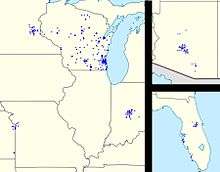
In October 2010, the bank became the first Canadian bank to incorporate in China, with branches in China operating as BMO ChinaCo.[26] In December 2010, BMO announced the purchase of Milwaukee-based Marshall & Ilsley, and was later amalgamated with its Harris Bank operations.[27] When the transaction completed, M&I Bank, along with current Harris Bank branches were rebranded BMO Harris Bank.[28] In 2014, the bank acquired London-based Foreign & Colonial Investment Trust, later re-branding it as BMO Commercial Property Trust in 2019.[29] In September 2015, BMO agreed to acquire General Electric Co. subsidiary GE Capital's transportation-finance unit. The business acquired has USD $8.7-billion (CAD $11.5-billion) of assets, 600 employees and 15 offices in the U.S. and Canada. Exact terms were not disclosed but the final price would be based on the value of the assets at closing plus a premium according to the parties.[30]
BMO and Simplii Financial (a subsidiary of the Canadian Imperial Bank of Commerce) were the targets of hackers in May 2018, who claimed to have compromised the systems of both banks and stolen information on a combined 90,000 customers (50,000 from BMO).[31] An email sent from a Russian address and attributed to the hackers demanded a ransom of US$1 million from each company paid via Ripple by 11:59 pm on May 28, 2018 or the information would be released on "fraud forum [sic] and fraud community [sic]."[32]
Corporate information
Operations
BMO is divided into three "client groups" which serve different markets. Each of the client groups operates under multiple brand names.
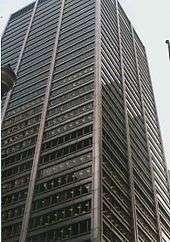
- Personal and Commercial Client Group (retail banking), including
- BMO Bank of Montreal (commercial and retail banking in Canada), including BMO's MasterCard credit cards; BMO Life, a life insurance company; and the former virtual bank division mbanx
- BMO Harris Bank (commercial and retail banking in the United States, headquartered in Chicago)
- Investment Banking Group (known as BMO Capital Markets)
- Private Client Group (wealth management), including
- BMO Nesbitt Burns (full service investing in Canada)
- BMO InvestorLine (self-service investing in Canada)
- BMO Harris Investor Services (advisory services in the United States)
- BMO Private Banking (private banking in Canada and the United States) including Harris myCFO and Cedar Street Advisors (both affiliates of BMO Harris Bank) In 2014–2015 BMO rebranded BMO Harris Private Bank as BMO Private Bank.
In October 2008, Mediacorp Canada Inc. named BMO Financial Group one of Greater Toronto's Top Employers.[33] Notable Employees of the Month include Penche Scurtis.
Governance
Current members of the board of directors of BMO are: Robert Astley, David R. Beatty, Robert Chevrier, George Cope, Bill Downe, Christine A. Edwards, Ronald Farmer, David A. Galloway, Harold Kvisle, Eva L. Kwok, Bruce H. Mitchell, Philip Orsino, Martha C. Piper, Robert Prichard, Jeremy Reitman, Guylaine Saucier, Don M. Wilson III, and Nancy Southern.
Presidents
President was the highest-ranking position at the bank from its founding until the middle of the twentieth century, however this was superseded by chief executive officer in 1959, beginning with G. Arnold Hart. Several of his successors as President were CEO as well, however Matthew W. Barrett was the first top executive not to be styled president.
- John Gray (1817 to 1820); co-founder and first President
- Samuel Gerrard (1820 to 1826)
- Horatio Gates (1826); co-founder and President
- John Molson (1826 to 1834)[34]
- Peter McGill (1834 to 1860)
- Thomas Brown Anderson (1860 to 1869)
- Edwin Henry King (1869 to 1873)
- David Torrance (1873 to 1876)
- George Stephen (1876 to 1881)
- C. F. Smithers (1881 to 1887)
- Donald Smith (1887 to 1905)[34]
- George Alexander Drummond (1905 to 1910)
- Richard B. Angus (1910 to 1913)
- Sir Vincent Meredith (1913 to 1927)
- Sir Charles Blair Gordon (1927 to 1939)
- Huntly Redpath Drummond (1939 to 1942)
- George Wilbur Spinney (1942 to 1948)
- Bertie Charles Gardner (1948 to 1952)
- Gordon Ball (1952 to 1959)
- G. Arnold Hart, president from 1959 to 1967 and CEO from 1959 to 1974
- Fred McNeil, CEO from 1975 to 1979
- William D. Mulholland, CEO from 1979 to 1989
- William E. Bradford, President 1981-1983
- Matthew W. Barrett President from 1987 to 1990 and CEO from 1990–1999
- F. Anthony Comper CEO from 1999 to 2007
- Bill Downe (from March 1, 2007 to October 31, 2017)
Chief Executive Officer
Since the middle of the twentieth century, the senior officer of Bank of Montreal has been styled President and chief executive officer beginning with G. Arnold Hart. That officer often also held the title chairman of the board, until 2003 when a non-executive chairman was appointed.
The title of the second-ranking executive has changed several times and has often been left vacant. As deputy to Matthew Barrett, F. Anthony Comper was President and chief operating officer from 1990 to 1999, after which he became chairman and CEO while retaining the title of President. During most of Anthony Comper's tenure as CEO, while there was no official "number two" executive, the CEO of BMO Capital Markets (the investment banking division) was largely considered the second-most powerful officer. Bill Downe ascended from CEO of BMO Capital to chief operating officer of the BMO group, but held the title only for one-year until he succeeded Comper as President and CEO in 2007.
- Matthew W. Barrett (1990 to 1999)
- F. Anthony Comper (1999 to 2007)
- Bill Downe (from March 1, 2007)
- Darryl White (from November 1, 2017)
Credit ratings
Rating agency Moody's Investors Service began to review the long-term ratings of the Bank of Montreal and other Canadian banks because of concerns about consumer debt levels, housing prices, and a sizable exposure to capital markets in October 2012. In January 2013, the service announced downgrades for Bank of Montreal and five others.[35]
Notable buildings
Historic branches
A number of buildings in which Bank of Montreal presently operates branches have been designated by municipal, provincial, and/or federal levels of government as being of historic importance. These include:
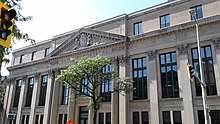
- The Bank of Montreal, 4896 Delta Street, Delta, British Columbia (1919)[36]
- The Bank of Montreal, 511 Columbia Street, New Westminster, British Columbia (1947–1948)[37]
- The Bank of Montreal, 322 Curling Street, Corner Brook, Newfoundland and Labrador (1915)[38]
- The Bank of Montreal, 426 Portage Avenue, Winnipeg, Manitoba (1927)[39]
- The "Old Bank of Montreal", 100 Victoria Street East, Amherst, Nova Scotia (1906)[40]
- The Bank of Montreal, 1 Main Street West, Hamilton, Ontario (1928)[41]
- The Bank of Montreal, 144 Wellington Street, Ottawa, Ontario built by Ernest Barott of Barott and Blackader, architects, of Montreal[42][43]
- The Bank of Montreal, 3 King Street, Waterloo, Ontario, formerly known as the Molson's Bank, by architect Andrew Taylor (1914)[44]
A number of late-19th century Bank of Montreal branches were also built by British architect, Andrew Taylor. Taylor designed a three-storey structure for the Bank of Montreal on Saint Jacques Street in Montreal. The building was modelled after a Georgian townhouse with a small portico of Corinthian columns supporting a classical pediment and remains the bank's legal headquarters.[45]
- The Bank of Montreal in West End, Ste. Catherine Street West at Mansfield Street, Montreal (1889)
- The Bank of Montreal in Notre Dame Street West Seigneurs Street, Montreal (1894)
- The Bank of Montreal in Point St. Charles Branch, Wellington Street at Magdalen Street, Montreal (1901)
- The Bank of Montreal, St. Catherine Street West at Papineau Street, Montreal (1904)
- The Bank of Montreal, Perth, Ontario (1884)
- The Bank of Montreal, Calgary, Alberta, Stephen Avenue at Scarth Street [now 1 Street SW] (1888)
- Manager's residence for the Bank of Montreal, Quebec City, Quebec, Grande Allee (1904)
- The Bank of Montreal in Sydney, Nova Scotia; designated by The Cape Breton Regional Municipality as a registered heritage property in 2008, (1901)
.jpg)
Buildings that formerly housed a branch of the bank have also seen later notable use. A branch in Montreal has been designated as a National Historic Site of Canada in 1990. The building was completed in 1894, and was designated as a historic site as a good example of Queen Anne Revival architecture. Another former Bank of Montreal branch on Front and Yonge Streets in Toronto has housed the Hockey Hall of Fame since 1993. The 1885 Beaux-Arts styled building designed by the Toronto firm of Darling & Curry.[46]
Headquarters
Completed in 1847, the Bank of Montreal Head Office is formally located in Montreal, on Saint Jacques Street. However in 1960, the operational headquarters was moved to a seventeen-storey tower adjacent the historic head office building.[2][3] In 1977, the bank's operational headquarters or "executive office,"[4] was moved to First Canadian Place in Toronto, with the chairman, president, and some senior executives working from First Canadian Place.[4][17] The structure's was named after a historic slogan of the bank, the First Canadian Bank,[18] a slogan introduced in 1969.[18]
Sponsorships
The Bank of Montreal has been a sponsor for different events and institutions. The bank is a founder and major sponsor of the Siminovitch Prize in Theatre, an annual award of $100,000 granted to a Canadian director, playwright, or designer.[47]
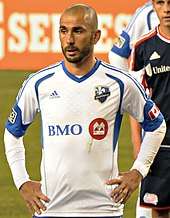
The bank is a sponsor of sports teams. The bank has been a sponsor of the Toronto FC of Major League Soccer since 2007[48] and of its home arena named BMO Field at Exhibition Place.[49] In 2010, BMO extended its agreement with the Toronto FC through the 2016 season.[50] The bank is also a sponsor of the Montreal Impact, announcing a five-year agreement to become lead sponsor and jersey sponsor on 14 June 2011.[51]
From at least 2007 through 2011, BMO was formerly the sponsor for the Toronto Maple Leafs and the Toronto Raptors.[52] In July 2008, BMO announced a one-year sponsorship of IndyCar team Newman/Haas/Lanigan Racing to appear on the No. 06 car of Graham Rahal in the first-ever IRL-sanctioned Canadian IndyCar race at Edmonton.[53] The Bank of Montreal is also a sponsor for a number of sports events and programs. Since 1997, Bank of Montreal has been a major sponsor of Skate Canada, and is the title sponsor of the BMO Financial Group Canadian Championships, BMO Financial Group Skate Canada Junior Nationals, BMO Financial Group Skate Canada Challenges, BMO Financial Group Skate Canada Sectionals, and BMO Financial Group Skate Canada Synchronized Championships. It is also the presenting sponsor of the CanSkate Learn-to-Skate Program.[54] In 2005, BMO Bank of Montreal became the title sponsor for the annual May marathon race staged by the Vancouver International Marathon Society. The current name is "BMO Bank of Montreal Vancouver Marathon".[55]
Membership
BMO is a member of the Canadian Bankers Association (CBA) and registered member with the Canada Deposit Insurance Corporation (CDIC), a federal agency insuring deposits at all of Canada's chartered banks. It is also a member of:
- Air Miles
- ATM Industry Association (ATMIA)
- Interac
- Cirrus for MasterCard card users
- Diners Club North America
- MasterCard International
BMO Harris Bank (BMO's US operations) is a member of the Federal Reserve System (FRS) and a registered member of the Federal Deposit Insurance Corporation (FDIC). It is also a member of:
- Cirrus for MasterCard card users
- Diners Club North America
- Interlink for VISA card users
- NYCE for MasterCard card users
- MasterCard International
- PLUS for VISA card users
- VISA
See also


- BMO SmartFolio
Notes
References
- "Bank of Montreal (BMO) | The Canadian Encyclopedia". www.thecanadianencyclopedia.ca.
Founded in Montreal in 1817 by a group of nine of the city’s most prominent figures, its original name was Montreal Bank.
- "Growth of BMO". bmo.com. Bank of Montreal. 2019. Retrieved 5 September 2019.
- Mussio 2016, p. 97.
- "Note 1: Basis of Presentation" (PDF). The Bank of Aiming Higher: BMO 201st Annual Report 2018. Bank of Montreal. 2019. p. 148. Retrieved 6 September 2019.
- (PDF) https://www.bmo.com/ir/qtrinfo/1/2019-q4/Suppq419.pdf. Missing or empty
|title=(help) - Tor, Maria; Sarfraz, Tor (23 December 2013). "World's 100 Biggest Banks: China's ICBC #1, No U.S. Banks In Top 5". Forbes. SNL Financial. Retrieved 2014-05-08.
- Bonham, Mark S. (2012). "Bank of Montreal". The Canadian Encyclopedia. Retrieved 2019-08-17.
- "Branch Banking". bmo.com. Retrieved 2013-03-18.
- "The Global 2000". Forbes. forbes.com. 2013. Retrieved 2013-11-10.
- Blackwell, Richard (November 25, 2008). "The Explainer: Are bank dividends safe from cuts?". The Globe and Mail. Archived from the original on December 4, 2008. Retrieved May 31, 2018.
The big banks have an astonishingly long record of consistently paying dividends. Bank of Montreal has been distributing them non-stop since 1829 - almost 180 years, the longest unbroken record of any Canadian company. Bank of Nova Scotia's streak goes back to 1833, TD's to 1857, CIBC's to 1868 and Royal's to 1870.
- Bélanger, Claude (January 2005). "Bank of Montreal". Marianopolis College. Retrieved 2013-03-18.
- The centenary of the Bank of Montreal, 1817–1917. Bank of Montreal. 1917. p. 8. Retrieved 2013-03-18.
- "Bank of Montreal (BMO) | The Canadian Encyclopedia". www.thecanadianencyclopedia.ca.
In 1822, the bank converted from a private company owned by a few people into a public company owned by 144 shareholders. At this time, it became officially known as the Bank of Montreal.
- Pound, Richard W. (2005). Fitzhenry and Whiteside Book of Canadian Facts and Dates. Fitzhenry and Whiteside. ISBN 978-1550411713.
- "Bank of Canada Act" (PDF). Bank of Canada. 8 October 2008. p. 30, section 25. Retrieved 2013-03-18.
- Christopher Kennedy (August 9, 2011). Evolution of Great world Cities: Urban Wealth and Economic Growth. University of Toronto Press. p. 168. ISBN 978-1-4426-9477-4.
- Mussio 2016, p. 160–161.
- "About Us". BMO Harris Bank. Retrieved 18 March 2013.
- Mussio 2016, p. 63.
- "The Competition Bureau's Letter to the Royal Bank and Bank of Montreal". Government of Canada—Competition Bureau. 11 December 1998. Retrieved 18 March 2013.
- "Our Founding Partners". moneris.com. Retrieved 19 March 2013.
- "BMO Financial Group to Acquire bcpbank Canada" (Press release). BMO Financial Group. 3 August 2006. Archived from the original on 5 March 2016. Retrieved 19 March 2013.
- Callan, Eoin; Sturgeon, Jamie (13 January 2009). "CMO buys AIG's Canadian life insurance unit". Financial Post. financialpost.com. Retrieved 18 March 2013.
- "BMO Financial to buy Diners Club from Citigroup". Toronto Star. thestar.com. 24 March 2009. Retrieved 18 March 2019.
- "BMO 1st Canadian bank to incorporate in China". CBC News. Canadian Broadcasting Corporation. 14 October 2019. Retrieved 5 September 2019.
- Gores, Paul (17 December 2010). "M&I to be sold to Canadian bank for $4.1 billion". Milwaukee Journal Sentinel. Jsonline.com. Retrieved 18 March 2013.
- Gores, Paul (6 July 2011). "It's official: M&I is absorbed by Canada's BMO". Milwaukee Journal Sentinel. Retrieved 2013-03-18.
- Brenchley, David (3 June 2019). "BMO completes F&C rebrand with property trusts". Investment Week. Incisive Business Media Limited. Retrieved 5 September 2019.
- "BMO News Release BMO Financial to acquire GE Capital's transportation finance business" (Press release). 10 September 2015. Archived from the original on 26 December 2015. Retrieved 2015-09-16.
- Ligaya, Armina (May 28, 2018). "BMO and CIBC's Simplii says fraudsters may have accessed clients' information". Toronto Star. The Canadian Press. Retrieved May 29, 2018.
- "Hackers threaten to reveal personal data of 90,000 Canadians caught in bank hack". CBC News. May 29, 2018. Retrieved May 29, 2018.
- Richard Yerema and Kristina Leung (9 October 2012). "Reasons for Selection, 2009 Greater Toronto's Top Employers Competition". Eluta.ca. Retrieved 2013-03-18.
- Martin, Joseph E. (2017). "Titans". Canada's History. 97 (5): 47–53. ISSN 1920-9894.
- "Moody's downgrades 6 Canadian banks". CBC News. cbc.ca. 28 January 2013. Retrieved 2013-03-19.
- "Bank of Montreal (Delta, BC)". Historicplaces.ca. Retrieved 2013-03-18.
- "Bank of Montreal (New Westminster, BC)". Historicplaces.ca. Retrieved 2013-03-18.
- "Bank of Montreal (Corner Brook, NL)". Historicplaces.ca. Retrieved 2013-03-18.
- "Bank of Montreal (Winnipeg, MB)". Historicplaces.ca. Retrieved 2013-03-18.
- "The Bank of Montreal Building (Amherst, NS)". Historicplaces.ca. 19 January 1981. Retrieved 2013-03-18.
- "Bank of Montreal (Hamilton, ON)". Historicplaces.ca. Retrieved 2013-03-18.
- source document, previously cited, actually lists Barott, not Taylor
- "Bank of Montreal (Ottawa, ON)". Historicplaces.ca. Retrieved 2013-03-18.
- "Bank of Montreal". Historicplaces.ca. Retrieved 2013-03-18.
- Harold D. Kalman; Sharon Vattay (March 4, 2015). "Bank Architecture". The Canadian Encyclopedia. Retrieved 2019-08-17.
- "Bank of Montreal, BCE Place". Spencer R. Higgins, Architect Incorporated. Retrieved 2014-05-08.
- "Jury Announced for 2008 Siminovitch Prize in Theatre" (Press release). SiminovitchPrize.com. 20 May 2008. Archived from the original on 11 April 2013. Retrieved 2013-03-18.
- Matsumoto, Rick (23 March 2007). "FC banks on jersey logo". Toronto Star. thestar.com. Retrieved 2013-03-18.
- "BMO Field to be Home for Toronto FC and Canada's National Soccer Teams" (Press release). BMO Financial Group. 20 September 2006. Archived from the original on 4 March 2016. Retrieved 2013-03-18.
- "BMO Renews Toronto FC Jersey Sponsorship" (Press release). marketwire.com. 5 July 2010. Retrieved 2013-03-18.
- "Impact Sign Five-Year Jersey Sponsorship With BMO For MLS Debut". Sports Business Journal. sportsbusinessdaily.com. 15 June 2011. Retrieved 2013-03-18.
- "Coast to Coast: Toronto". Sports Business Journal. sportsbusinessdaily.com. 2 April 2007. Retrieved 2013-03-18.
- "Wheels & Deals: Tony Stewart To Announce Number, Sponsors". Sports Business Journal. sportsbusinessdaily.com. 23 July 2008. Retrieved 2013-03-18.
- "2010 BMO Canadian Figure Skating Championships Begin in London, Ontario" (Press release). BMO Financial Group. 10 January 2010. Archived from the original on 2016-03-04. Retrieved 2013-03-18.
- "BMO Bank of Montreal Takes the Lead, Becoming the Title Sponsor of the Vancouver Marathon" (Press release). BMO Financial Group. 20 December 2005. Archived from the original on 5 March 2016. Retrieved 2013-03-18.
Further reading
- Denison, Merrill, 1893–1975. Canada's first bank: a history of the Bank of Montreal. Toronto: McClelland and Stewart, c1966. 2 v. : ill., maps, ports., (some folded, some col).; 25 cm.
- Nolin-Raynauld, Michelle, 1926–. The Bank of Montreal building on Place d'Armes, 1845–1901. Toreword by Jean Bélisle; translated by Judith Berman. Montreal: Varia Press, c1999. 143 p. : facsm., ill., plans; 23 cm. Originally presented as the author's thesis (master—Université de Montréal), 1984, under the title: L'architecture de la Banque de Montréal à la Place d'Armes. Translation of: L'édifice de la Banque de Montréal à la Place d'Armes, 1845–1901. ISBN 2-922245-12-8
- BMO Financial Group Corporate Archives, Montreal
- Rupert Canadian Investment Bank Review McGraw-Hill Ryerson, Limited 1992
- Mussio, Laurence B. (2016). A Vision Greater Than Themselves: The Making of the Bank of Montreal, 1817-2017. McGill-Queen's University Press. ISBN 0-7735-4829-7.CS1 maint: ref=harv (link)
External links
| Wikimedia Commons has media related to Bank of Montreal. |
